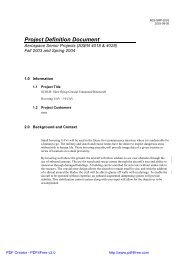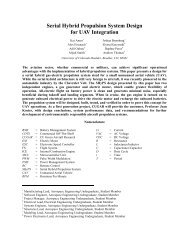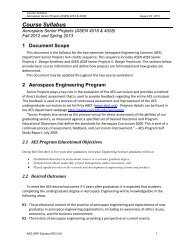PFR - Aerospace Engineering Sciences Senior Design Projects ...
PFR - Aerospace Engineering Sciences Senior Design Projects ...
PFR - Aerospace Engineering Sciences Senior Design Projects ...
You also want an ePaper? Increase the reach of your titles
YUMPU automatically turns print PDFs into web optimized ePapers that Google loves.
Project Final Report – CUDBF April 30 th , 2009<br />
ASEN 4028: <strong>Aerospace</strong> <strong>Senior</strong> <strong>Projects</strong><br />
To determine the moment of inertia for the airfoil cross-section, a few assumptions were<br />
made. To simplify the cross-sectional shape, the foam was neglected and a thin-walled ellipse of<br />
balsa was selected as seen in Figure 55.<br />
Figure 55: Thin-Walled Ellipse<br />
Since the taper and sweep are not considered, the mean aerodynamic chord of 16.6 inches was<br />
selected as the semi-major axis. The semi-minor axis was defined as the airfoil thickness at the<br />
mean aerodynamic chord. The average thickness-to-chord ratio of 0.9 was used to give the semiminor<br />
axis a value of 0.375 inches (0.75 for the entire thickness). Using the balsa thickness of<br />
1/32 inch, Equation 26 produces the moment of inertia [23] of approximately 0.7 in 4 .<br />
= 4 1 + 3<br />
<br />
Equation 26: Moment of Inertial for Thin Walled Ellipse<br />
8.4.2 Wing Material Selection<br />
The wing design materials were selected to minimize overall weight while still meeting the<br />
minimum wing design-to-specifications. A foam-core made of EPS foam (Expanded<br />
Polystyrene Foam) was selected after the foam-core and skin composite construction technique<br />
was selected over the traditional rib and spar construction. Additional analysis was done in order<br />
to select an optimum skin material from balsa, fiber-glass, or carbon fiber. The most significant<br />
resource employed in the skin material selection process was a Young’s modulus vs. Density<br />
Ashby plot [24] .The two significant Ashby charts are displayed within Figure 56 and Figure 57,<br />
the balsa and composites Ashby charts respectively.<br />
84
















